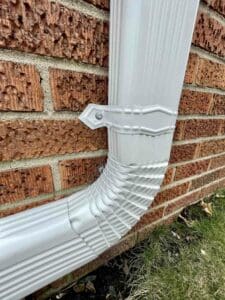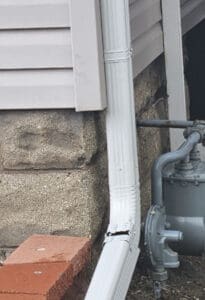When it comes to gutter and downspout installation, hiring a professional contractor is the best way to ensure that your new gutters are installed correctly and will function properly. However, even professional contractors use shortcuts to simplify the installation process and save themselves time and money. There are two trains of thought — take your time and pay attention to quality, or do it quick and cheap. In this article we will expose some of the main shortcuts and do our best to give you both sides of the argument so you can made an educated decision and get the best quality results for your budget.
Securing a Downspout Strap
There are so many ways to do strapping that a professional installer who sees a shortcut job will feel like the top of his head is going to pop off. First, consider that a strap is supposed to secure a downspout onto a wall. Downspout straps are embossed with the most decorative side being the middle of the strap. They are made to go across the face of the gutter and be secured with two fasteners to the building and that’s why we use two screws.

Downspouts and elbows should have straps over them to secure the bottom and the top, while hiding the seam
The most common way to install a downspout is to use one screw into the building. The strap is screwed right through through tiger middle. With that method, the installer saves a few seconds by burying the most decorative part of the strap behind the downspout. Then they just wrap the ends around to the front and put a few screws through the dog ears and into the downspout. It’s fast, it’s easy and requires no skill.
Decorative straps are embossed by the manufacturer for a reason. There is no reason to bury the most decorative part of a downspout strap.
Downspout Strap Location
Care should be taken to place the strap over the seam between downspout elbows and downspouts. Because while you can do a seamless gutter, there is no such thing as a seamless downspout. By placing them over the seam, you will assure that the top part will have strength and security as well as the bottom part. To not pay attention to location is simply careless.
Scrap Straps vs Pre-fabricated Straps or back brackets
There are times when specialty colors just aren’t available with all of the accessories needed for a good gutter and downspout install and that’s the only time when I can excuse not using the embossed ones. When your gutters are rolled out onsite, as any even nominally decent installer will do, the aluminum comes in coils and an installer will typically extrude it into the shape of a k-style gutter and be able to lay it out right there on your lawn.
If they forgot to buy the straps, or the supplier didn’t have the straps, or if they didn’t want to spend the money on the straps, they’ll simply take a piece of the gutter coil, cut off a strip, screw it to the building, put the downspout up against it and then wrap it around the downspout. It is then secured with a screw or two. If there is a plus, it is that it is the same color as the downspouts (sometimes suppliers may not have the same color straps). At least with this technique the strap can be secured across the seam between the elbow and the downspout.
Back brackets are U-shaped brackets that are screwed into the building, then the downspout goes into the U-groove and the downspout is screwed into the bracket. They only provide strength to the downspout.
Screwing on Extenders
While no one wants their downspout extenders to blow off or take a walk, screwing an extender onto a downspout is likely to cause a problem. Children, pets, wildlife, lawnmowers and anything that could possibly bump into a downspout can damage it — more especially if you create a situation where a downspout extender could put torque on a downspout which could loosen it, damage it or just rip it off of the wall. A much wiser option is to pressure fit the downspout extender onto the elbow on the bottom of the downspout. That way, if they do have any sort of random bumping or impact, they’ll simply fall off of the downspout elbow and it won’t damage the downspout. Simply slide it back on and reattach it by hand.
Using Downspout Hinges

How not to install downspouts
Hinges work great — until they don’t. They tend to twist, crack, bend and break. Parts of them rust and while they look beautiful on the day of install, they are an abomination in the long run. They create weak points in a gutter system and the downspouts just don’t function well after hinges go bad. They are typically sold as great solutions for cutting your grass – just lift them up and they will stay up until you’re done mowing and then you just go tip them down. How this is easier than sliding off and on a well tapered downspout extender is beyond me, but some people love the concept. After they break or get damaged, you have to replace them.
No Rubber Washers for Strap Screws
Galvanic corrosion is when two dis-similar metals, like a steel screw, comes in contact with another type of metal like an aluminum downspout strap for your gutters. They corrode, quickly rust and break down. There’s a simple trick that professional gutter installers know about and that is to use a galvanized pole barn screw with a rubber washer. The rubber washer is just enough to keep the head of the steel screw away from the aluminum strap. That makes it so it doesn’t corrode.
Use an Impact Driver instead of a Power Drill
Professional grade tools are only as good as the person using them. Yes, a power drill can drill a screw into a building, but an impact driver, which looks very similar to a power drill, is made to tighten a screw better without stripping out the head of the screw.
Heavier gauge is better
Downspouts come in various thicknesses. The industry standard for professional contractors is .019 but your better contractors will use .024 if available. Most big box stores will sell .016 which is more of a DIY or Handyman thickness. Yes, they’re cheaper but they’re also more prone to tear. It may sound silly, but give your downspouts a squeeze and it should be fairly easy to tell which thickness you would choose.
BONUS
Downspouts sound cool when you jump on them (for 4 year old boys)
In over 20 years in the industry, the most common reason I’ve heard for customers calling back to get their downspout extenders replaced is that a child, be it their own or a grandchild, jumped on them. Yes, it sounds silly but I kid you not. So what is the solution? Believe it or not, this is one of those cases when I recommend that homeowners buy the cheap little plastic extenders from the local hardware store. They only extend a few feet and if you need a longer piece, you can get the long black corrugated tubing and attach a rectangle-t0-circle adapter. Kids are hard pressed to destroy these and if they do somehow manage to, they are inexpensive to replace.
Chipmunks and Dogs
You’ve seen this happen. A dog thinks he’s got a live play toy and a terrified chipmunk runs into a downspout extender in fear for his life. The dog barks in the end, pulls on the downspout and the horrified little garden rodent does his best to stay in the middle, hoping his heart doesn’t explode before the dog gets bored and runs away.

